Flexible facade stone, stone veneer or flexible facade is an original facing material that imitates natural stone (sandstone, marble, etc.). It differs from analogs in its natural texture, transferred without errors to an artificial basis.
Manufacturing and characteristics
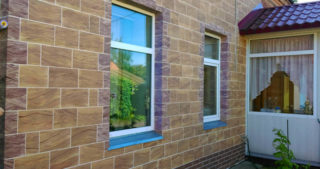
In general, flexible stone is an especially thin material, which consists of three layers:
- Cloth or non-woven fabric.
- An adhesive based on epoxy glue.
- A crumb or thin plate of natural stone.
The technology for the production of stone veneer was first proposed in Germany. Initially, the whole process was carried out in quarries, where deposits of stones with an original cut were found. The selected stones were cut into the required size and subjected to careful processing (cleaning, grinding, polishing). An adhesive was applied to the back of the resulting thin plates and a special fabric (woven or non-woven) was applied to it.
After the adhesive had completely dried, using a special machine, the resulting "layer cake" was cut in such a way that a thin layer of stone, similar to veneer, remained on the fabric base. Thus, a flexible sheet was obtained that imitated the natural pattern of the stone.
Such facing material very soon gained popularity, as it possessed a number of advantages in comparison with natural stone. However, at the same time, there were difficulties that significantly hampered its serial production:
- the need for a deposit of stone with an original texture;
- high costs for organizing production and a long process of manufacturing the material itself, as a result of which the invested funds are not recouped by the output of finished products.
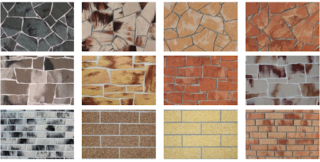
Manufacturers of flexible stone are increasingly switching to its industrial production in specially prepared workshops. At the same time, the range of finished products has also significantly expanded - by mixing various ingredients, it became possible to obtain a varied appearance of the facing material, identical to natural stone. For example, if iron oxide is added to marble chips that are applied to a flexible substrate, the marble takes on a pink or red hue depending on the amount of pigment. The addition of iron sulphide gives the marble a bluish-black color.
The tactile and visual sensations that arise when examining samples of flexible stone obtained under conditions of mass production are no different from products made directly in quarries.
On the market of facing materials, flexible veneer is found in the form of slabs and rolls. Plates have a thickness of 2.5 mm and dimensions (cm): 5x60, 20x30, 60x30, 80x40, 260x130. The buyer may come across boards on a substrate of MDF (medium-density fiberboard) with a thickness of 6 mm. Their dimensions are 250x100 cm. The rolls are 102 or 120 cm wide, and the length varies from 2.0 to 2.8 m, and the layer of stone on them does not exceed 1 mm.
Specifications
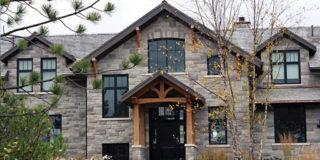
Flexible stone for the facade, like any other building material, has a number of technical parameters:
- operating temperature range - from -45 to +700 ° С;
- weight - no more than 4 kg / m²;
- inner surface - fiberglass or cloth;
- outer surface - natural stone - not less than 91%;
- binder - polymer dispersion - not less than 8%;
- vapor permeability - 0.0052 mg / m / h P;
- frost resistance - at least 100 freezing cycles;
- flammability group according to GOST 30244-94 (SNiP 21-0197) - G1 (slightly flammable).
The outer side of the slabs or rolls imitates different types of stone. If stone chips are used, the drawing can have any shade or imitate other types of materials. A flexible stone must have a natural texture and high elasticity.
When choosing a flexible stone for the facade of a house, check with the sellers for a certificate, otherwise you risk buying a fake that does not meet the parameters declared by the manufacturer.
Advantages and disadvantages
The flexible facade is practically devoid of disadvantages. The only thing that slows down its distribution is the cost, which is commensurate with the price of natural stone. However, this disadvantage is offset by the advantages of flexible stone. When the weight of the structure is the deciding factor, stone veneer is second to none.
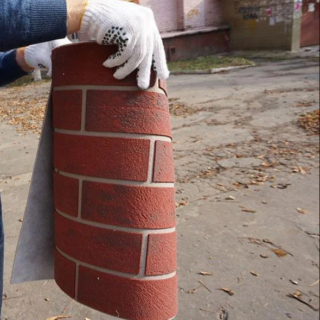
Advantages:
- moisture resistance;
- high decorative properties - the chaotic arrangement of stone elements and the use of various coloring pigments provides a unique, inimitable pattern on the surface of the facing material;
- flexibility;
- heat resistance;
- environmental friendliness;
- ease of installation - the material is easily cut with scissors and does not require special training and the presence of a specific tool when performing work;
- immunity to changes in climatic and atmospheric influences;
- long service life - correct installation and observance of the operating rules ensures the service life of the material not less than 35 years.
The disadvantages of flexible stone include a short service life (facing with natural stone can last more than 70 years). In addition, when facing the outer surfaces of a building, it is necessary to use a finishing protective coating, which does not always suit the consumer.
Scope and installation technology
Stone veneer is used for facing the facade and basement of buildings, fences and other structures. Also, the material can be used to decorate fireplaces and other heating surfaces.
To mount a flexible stone on the outer surface of buildings, you will need:
- wide brush;
- stationery knife;
- brush;
- spatulas (even and notched);
- rubber roller and paint roller;
- the hair dryer is construction.
For reliable fastening of the cladding to the wall, it is necessary to use adhesives recommended by the manufacturer of the material.
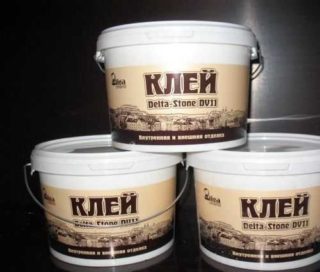
The process of cladding the external surfaces of buildings and structures is in many ways similar to pasting walls with wallpaper.
It is necessary to pay attention to the ambient temperature, which should not be lower than + 12 ° С, and take into account the need for a final two-layer priming of the surface
It is important to clean the wall and the inside of the cladding material from dirt. Before applying the glue to the wall, it must be dried and primed. In order to glue the facing material evenly, it is recommended to mark the wall with a pencil. The adhesive is applied only to the wall, the inner surface of the cladding must be dry.
The material is glued from top to bottom, starting from any upper corner and smoothed with a rubber roller. When finishing the corners, the corresponding part of the "stone" cloth is heated with a hairdryer and, after wrapping, is pressed tightly with a spatula.
After the glue has dried, the flexible facade is primed twice with a special hydrophobic compound (included with the flexible stone).
The primer must completely saturate the facing material, which will reliably protect it from adverse environmental influences.








